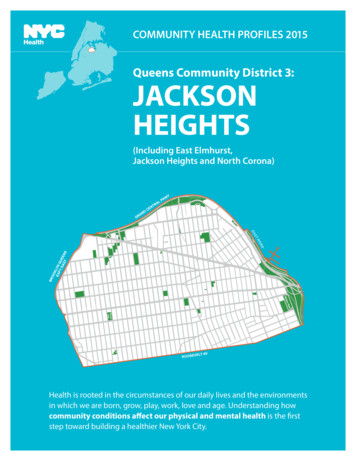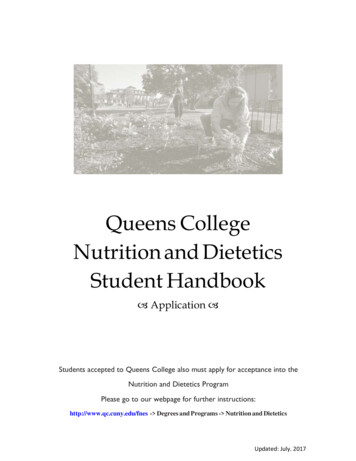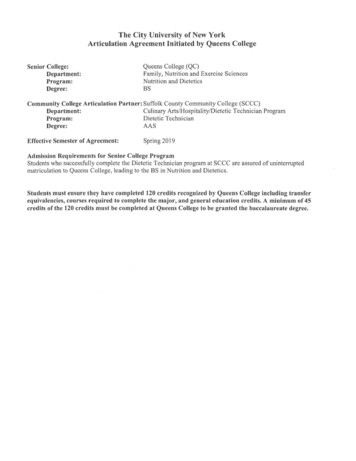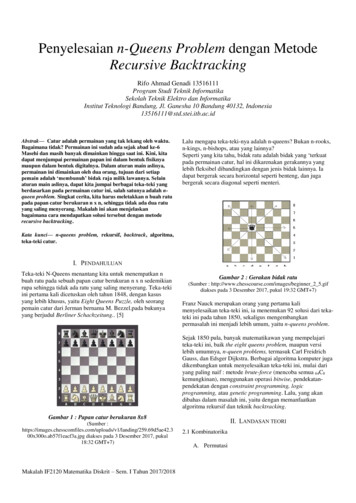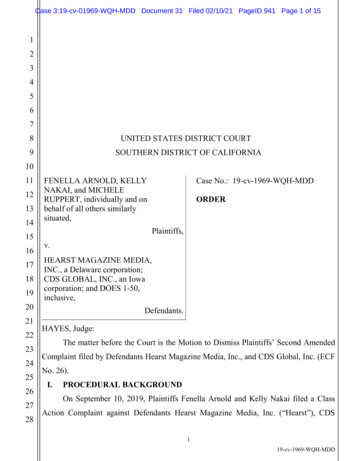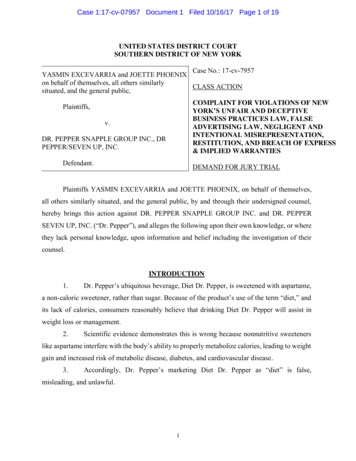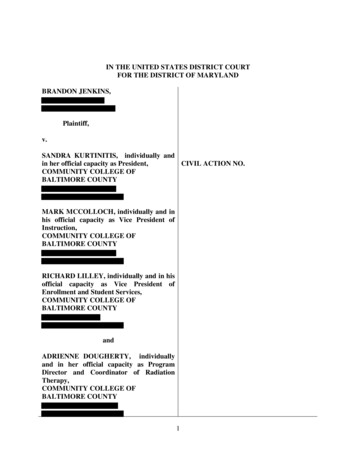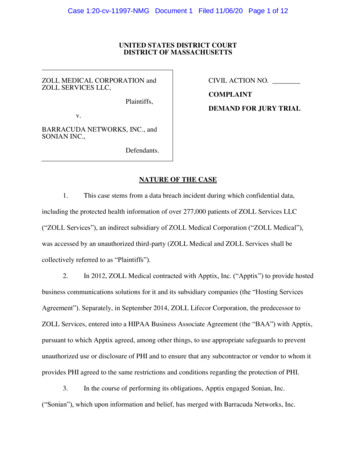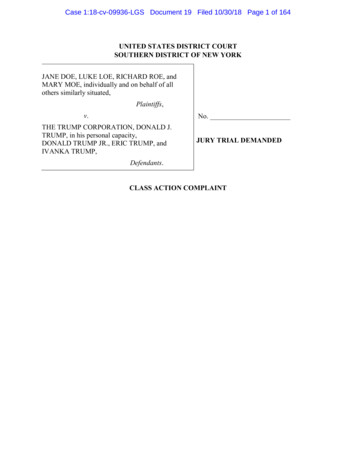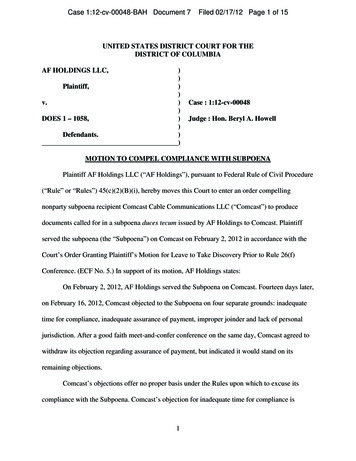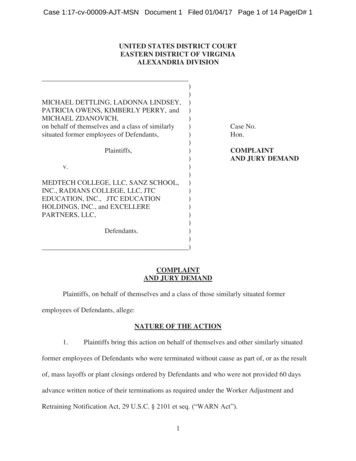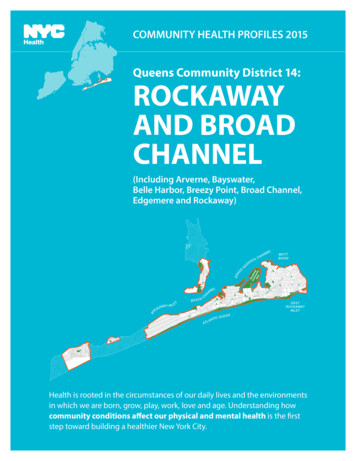
Transcription
COMMUNITY HEALTH PROFILES 2015Queens Community District 14:ROCKAWAYAND BROADCHANNEL(Including Arverne, Bayswater,Belle Harbor, Breezy Point, Broad Channel,Edgemere and Rockaway)Health is rooted in the circumstances of our daily lives and the environmentsin which we are born, grow, play, work, love and age. Understanding howcommunity conditions affect our physical and mental health is the firststep toward building a healthier New York City.
115,657ROCKAWAY AND BROAD CHANNEL TOTAL POPULATIONWHO WEARE12345678POPULATION BY RACE and ETHNICITY40% Black*91034% White*22% Hispanic3% Asian*2% Other*Population By AGE26%25% 25%NYC14%9%0–170 - 1718–2418-2425–4425-4445–6445-6465 65 Percent who reportedtheir own healthas “EXCELLENT,””VERY GOOD” or “GOOD”79%27%NYCAREFOREIGNBORNHAVE LIMITEDENGLISHPROFICIENCY14%LIFE EXPECTANCY75.9YEARS* Non-HispanicNote: Percentages may not sum to 100% due to roundingSources: Overall population, race and age: U.S. Census Bureau Population Estimates, 2013; Foreign born and English proficiency: U.S. Census Bureau, American Community Survey, 2011-2013; Self-reported health: NYC DOHMH Community Health Survey,COMMUNT Y H ENYCA LTH PROofFILS 2 02003-20121 5 : ROC K AWAY A ND BR OA D C HA NNE L2011-2013;LifeI Expectancy:DOHMHBureauVital EStatistics,2
Note from Dr. Mary Bassett,Commissioner, New York City Departmentof Health and Mental HygieneNew York City is a city of neighborhoods. Their diversity, rich historyand people are what make this city so special.But longstanding and rising income inequality, combined with ahistory of racial residential segregation, has led to startling healthinequities between neighborhoods. Poor health outcomes tendto cluster in places that people of color call home and where manyresidents live in poverty. Life expectancy in Brownsville, for example,is 11 years shorter than in the Financial District. And this is not becauseresidents of Brownsville are dying of unusual diseases, but becausethey are dying of the same diseases – mostly heart disease andcancer – at younger ages and at higher rates.This is unfair and avoidable. A person’s health should not bedetermined by his or her ZIP code.Reducing health inequities requires policymakers, healthprofessionals, researchers and community groups to advocate andwork together for systemic change. In One New York: The Plan fora Strong and Just City (OneNYC), Mayor Bill de Blasio has outlined avision to transform this city, and every neighborhood, guided by theprinciples of growth, equity, sustainability and resiliency.Our communities are not simply made up of individual behaviors, butare dynamic places where individuals interact with each other, withtheir immediate environments and with the policies that shape thoseenvironments. The Community Health Profiles include indicators thatreflect a broad set of conditions that impact health.Our hope is that you will use the data and information in theseCommunity Health Profiles to advocate for your neighborhoods.Mary T. Bassett, MD, MPHCOMM U N I T Y H E A LT H PR O FIL E S 2 0 1 5 : ROC K AWAY A ND BR OA D C HA NNE L3
Navigatingthis documentThis profile covers all of QueensCommunity District 14, whichincludes Averne, Bayswater,Belle Harbor, Breezy Point,Broad Channel, Edgemere andRockaway, but the name isshortened to just Rockawayand Broad Channel. This isone of 59 community districtsin New York City (NYC).Community districts are rankedon each indicator. The highestrank (#1) corresponds to thelargest value for a given measure.Sometimes a high rank indicatesa positive measure of health(e.g., ranking first in fluvaccination). Other times, itindicates a negative measureof health (e.g., ranking first inthe premature death rate).The following color codingsystem is used throughoutthis document:TABLE OF CONTENTSWho we arePAGE 2NEIGHBORHOOD CONDITIONSPAGE 5SOCIAL AND ECONOMICCONDITIONSPAGEs 6 and 7Healthy livingPAGEs 8 and 9HEALTH CAREPAGE 10Health OutcomesPAGEs 11, 12 and 13ROCKAWAY ANDBROAD CHANNELBEST-PERFORMINGCOMMUNITY DISTRICTNOTESPAGES 14 AND 15QUEENSNEW YORK CITYMAP AND CONTACTINFORMATIONBACK COVERCOMM U N I T Y H E A LT H PR O FIL E S 2 0 1 5 : ROC K AWAY A ND BR OA D C HA NNE L4
Housing qualityPoorly maintained housing is associated with negative health outcomes, including asthmaand other respiratory illnesses, injuries and poor mental health. A similar percentage of homesin Rockaway and Broad Channel have maintenance defects compared with homes citywide.Maintenance defects(percent of renter-occupied homes with at least one maintenance defect)NEIGHBORHOODCONDITIONS100%Maintenance defects include water leaks, cracks and holes, inadequateheating, presence of mice or rats, toilet breakdowns and peeling paint.NYC59%50%Where we livedetermines thequality of the air webreathe, the homeswe live in, how safewe feel, what kindsof food we caneasily accessand more.QUEENS51%0%Tottenville and Great Kills18%Rockaway and Broad Channel66%(RANKS 59TH)(RANKS 22ND)NYC Housing and Vacancy Survey, 2011Air pollutionAlthough NYC air quality is improving, air pollution, such as fine particles (PM2.5), can causehealth problems, particularly among the very young, seniors and those with preexisting healthconditions. In Rockaway and Broad Channel, levels of PM2.5, the most harmful air pollutant,are 7.6 micrograms per cubic meter, compared with 8.4 in Queens and 8.6 citywide. Rockaway59 58 57 56 55 54 53 52 51 50 49 48 47 46 45 44 43 42 41 40 39 38 37 36 35 34 33 32 31 30 29 28 27 26 25 24 23 22 21 20 19 18 17 16 15 14 13 12 11 10 09 08 07 06 05 04 03 02 01and Broad Channel has the lowest levels of PM2.5 in the city.Air pollution (micrograms of fineBestparticulate matter per cubic meter)Best7.6Best inNYCRockaway andBroad Channel8.48.6QueensNYC(RANKS 59TH)NYC DOHMH, Community Air Survey, 2013Retail environmentWhen healthyfoods are readilyavailable, it iseasier to makehealthy choices.Tobacco retailers are less prevalent in Rockaway and Broad Channel than in the cityoverall. There is greater supermarket access than in the city as a whole, with 269 square feetper 100 people.Tobacco retailersSupermarket square footage(per 10,000 population)7(per 100 population)6269450Rockaway andBroad ChannelBayside andLittle NeckTHRockaway andBroad ChannelSouth Beach andWillowbrook911180177(RANKS 52ND)Queens(RANKS 59 )NYCNYC Department of Consumer Affairs, 2014COMM U N I T Y H E A LT H PR O FIL E S 2 0 1 5 : ROC K AWAY A ND BR OA D C HA NNE L(RANKS 9TH)Queens(RANKS 1ST )NYCNew York State Department of Agriculture and Markets, 20145
Adult educational attainmentIn Rockaway and Broad Channel, one-third of adults have college degrees; however,nearly a quarter of adults have not completed high school.Highest level of education attained (adults 25 years and older)ROCKAWAY ANDBROAD CHANNELFINANCIAL DISTRICT &GREENWICH VILLAGE AND SOHO84%College graduate32%College graduateSocial andEconomicConditions45%High school graduateor some college12%High school graduateor some college23%Less than high school4%Less than high schoolNEW YORK CITYQUEENSHigher educationlevels are associatedwith better healthoutcomes.38%College graduate41%College graduate42%High school graduateor some college39%High school graduateor some college20%Less than high school20%Less than high schoolU.S. Census Bureau, American Community Survey, 2011-2013IncomeOne in fiveRockaway andBroad Channelresidents livesbelow theFederal PovertyLevel.Living in poverty limits healthy lifestyle choices and makes it difficult to access healthcare and resources that can promote health and prevent illness. Unemployment andunaffordable housing are also closely associated with poverty and poor health. About onein nine Rockaway and Broad Channel adults ages 16 and older is unemployed, and overhalf of residents spend more than 30% of their monthly gross income on rent.One way to consider the effect of income on health is by comparing death rates amongneighborhoods. Assuming that the death rates from the five neighborhoods with thehighest incomes are achievable in Rockaway and Broad Channel, it is estimated that46% of deaths could have been averted.Economic stressRockaway andBroad ChannelPovertyUnemployment19%(RANKS 31ST )11%(RANKS 25TH)Best-performingcommunity districtQueensNYC6%16%21%10%11%53%51%Tottenville and Great Kills(RANKS 59TH)5%Greenwich Village and Soho& Financial District(RANKS 58TH)Rentburden52%(RANKS 31ST )37%Greenwich Village and Soho& Financial District(RANKS 58TH)Poverty, unemployment and rent burden: U.S. Census Bureau, American Community Survey, 2011-2013, Avertable deaths: NYC DOHMH, Bureau of Vital Statistics 2008-2012COMM U N I T Y H E A LT H PR O FIL E S 2 0 1 5 : ROC K AWAY A ND BR OA D C HA NNE L6
Children and adolescentsThe littlest New Yorkers all deserve the same opportunities for health. In Rockawayand Broad Channel, the rate of preterm births, a key driver of infant death, is fourthhighest in the city, the teen birth rate is higher than the Queens rate, and the rate ofelementary school absenteeism is the highest in Queens.Social andEconomicConditionsPreterm births11.65.7*8.49.0Rockaway andBroad NYC(percent of all live births)(RANKS 4TH)Teen births(per 1,000 girls ages 15-19)Child andadolescent healthare a signal ofa community’scurrent well-beingand potential.(RANKS 59TH)26.4Rockaway andBroad Channel(RANKS 22ND)Elementary schoolabsenteeism28(percent of students missing20 or more school days)Rockaway andBroad Channel(RANKS 16TH)1.1*FinancialDistrict(RANKS 59TH)4FinancialDistrict(RANKS 59TH)* Interpret estimate with caution due to small number of eventsPreterm births: NYC DOHMH, Bureau of Vital Statistics, 2013; Teen births: NYC DOHMH, Bureau of Vital Statistics, 2011-2013; Absenteeism: NYC Department of Education, 2013-2014People who areIncarcerationincarcerated haveJail incarceration (per 100,000 adults ages 16 and older)higher rates of400mental illness,The incarceration rate indrug and alcoholRockaway and Broad Channelis higher than the Queens rate.addiction and other200health conditions.NYC930Non-fatal assaulthospitalizationscapture theconsequencesof communityviolence.QUEENS52Queens Village5*Rockaway and Broad Channel88(RANKS 59TH)(RANKS 26TH)NYC Department of Corrections, 2014*Interpret estimate with caution due to small number of eventsViolenceThe injury assault rate in Rockaway and Broad Channel is higher than the citywide rate.Non-fatal assault hospitalizations (per 100,000 population)80114164Rockaway andBroad ChannelRego Park andForest HillsQueensNYC59 58 57 56 55 54 53 52 51 50 49 48 47 46 45 44 43 42 41 40 39 38 37 36 35 34 33 32 31 30 29 28 27 26 25 24 23 22 21 20 19 18 17 16 15 14 13 12 11 10 09 08 07 06 05 04 03 02 01(RANKS 19TH)(RANKS 59TH)New York State Department of Health, Statewide Planning and Research Cooperative System, 2011-2013COMM U N I T Y H E A LT H PR O FIL E S 2 0 1 5 : ROC K AWAY A ND BR OA D C HA NNE L7
Self-reported healthPeople are good at rating their own health. When asked to rate their overall health ona scale of one to five (excellent, very good, good, fair or poor), 79% of Rockaway andBroad Channel residents rate their health as “excellent,”“very good” or “good.”Percent who self-reported their own health as “excellent,”“very good” or “good”HEALTHYLiving79%Rockaway andBroad Channel79%92%Upper East Side(RANKS 1ST)78%QueensNew York CityNYC DOHMH, Community Health Survey, 2011-2013(RANKS 32ND)Smoking, diet and physical activitySmoking, poor quality diet and physical inactivity are risk factors for high bloodpressure, diabetes and other problems. Adults in Rockaway and Broad Channelsmoke, eat fruits and vegetables and are physically active at rates similar to residentsof Queens and NYC. However, adults in Rockaway and Broad Channel are morelikely to consume sugary drinks than adults citywide.Rockaway andBroad ChannelAdults inRockaway andBroad Channel arealmost three timesas likely to consumesugary beveragesas StuyvesantTown and TurtleBay adults.Currentsmokers1 or more12 oz sugarydrink per dayAt least oneserving offruits orvegetablesper dayAny physicalactivity in thelast 30 days17%(RANKS 20TH)Best-performingcommunity districtQueensNYC10%15%15%28%27%89%88%76%77%East Flatbush(RANKS 59TH)35%(RANKS 14TH)12%Stuyvesant Townand Turtle Bay(RANKS 59TH)90%(RANKS 20TH)95%*Bayside andLittle Neck(RANKS 1ST)81%(RANKS 10TH)90%Clinton andChelsea & Midtown(RANKS 1ST)*Interpret estimate with caution due to small sample sizeCOMM U N I T Y H E A LT H PR O FIL E S 2 0 1 5 : ROC K AWAY A ND BR OA D C HA NNE LAll: NYC DOHMH, Community Health Survey, 2011-20138
Obesity and diabetesObesity can lead to serious health problems such as diabetes and heart disease. At 28%, therate of obesity in Rockaway and Broad Channel is over three times the rate in StuyvesantTown and Turtle Bay. The diabetes rate in Rockaway and Broad Channel is 10%, similar tothe rate in NYC overall.HEALTHYLivingExercise is oneway to maintaina healthy weight.Federal guidelinessay that childrenshould get 60minutes of exerciseper day, adultsshould get 150minutes per week,and older adultsshould get 150minutes per weekas their physicalabilities allow, witha focus on exercisesto improve balance.Obesity (percent of adults)ROCKAWAY ANDBROAD CHANNEL28%ROCKAWAY ANDBROAD CHANNEL8%STUYVESANTTOWN ANDTURTLE BAY(RANKS 59TH)(RANKS 22 )NDSTUYVESANTTOWN ANDTURTLE BAY(RANKS 59TH)Diabetes (percent of adults)QUEENS21%NYC24%(RANKS 34TH)10%3%QUEENS10%NYC10%NYC DOHMH, Community Health Survey, 2011-2013NYC DOHMH, Community Health Survey, 2011-2013Substance useDrug- and/or alcohol-related hospitalizations reflect acute and chronic consequencesof substance misuse. In Rockaway and Broad Channel, alcohol-related hospitalizationrates are higher than the rates in Queens and NYC; Rockaway and Broad Channel rankshighest in Queens in alcohol- and drug-related hospitalizations.Alcohol-related hospitalizations (per 100,000 adults)1,112Rockaway andBroad Channel(RANKS 24TH)6381,019QueensNYC233Bayside andLittle Neck(RANKS 59TH)New York State Department of Health, Statewide Planning and Research Cooperative System, 2012Drug-related hospitalizations (per 100,000 adults)748Rockaway andBroad Channel(RANKS 29TH)159Rego Park andForest Hills357907QueensNYC(RANKS 59TH)New York State Department of Health, Statewide Planning and Research Cooperative System, 2012COMM U N I T Y H E A LT H PR O FIL E S 2 0 1 5 : ROC K AWAY A ND BR OA D C HA NNE L9
Access to health careA lack of quality health care can lead to negative health outcomes and moreintensive treatment, such as avoidable hospitalizations. Sixteen percent of adults inRockaway and Broad Channel have no health insurance, and one in eleven goes withoutneeded medical care, similar to citywide rates. However, the rate of late or no prenatalcare in Rockaway and Broad Channel is higher than the Queens and citywide rates.HEALTH CARENo healthinsuranceWent withoutneeded medical care(percent of adults)Prior to 2014, 20%of adults in NYChad no healthinsurance;however, withimplementationof the AffordableCare Act, thispercentagedecreased to 14%citywide in 2014.A similar decreaseis expected inRockaway andBroad Channel.HPV infectioncauses cancersthat can beprevented bythe HPV vaccine.Boys and girlsshould receivethe vaccine at11 to 12 years ofage, prior to HPVexposure andwhen the vaccineis most effective.ROCKAWAYAND BROADCHANNEL(percent of adults)ROCKAWAYAND BROADCHANNEL16%(RANKS 47TH)TOTTENVILLEAND GREATKILLS(RANKS 59TH)Late or noprenatal care(percent of live births)ROCKAWAYAND BROADCHANNEL9%(RANKS 44TH)8%UPPEREAST SIDE(RANKS 59TH)QUEENS22%NYC20%NYC DOHMH, Community Health Survey, 2011-201311.7%(RANKS 12TH)5%TOTTENVILLEAND GREATKILLS(RANKS 59TH)1.3%QUEENS11%QUEENS9.0%NYC11%NYC7.4%NYC DOHMH, Bureau of Vital Statistics, 2013NYC DOHMH, Community Health Survey, 2011-2013Prevention and screeningCompared with teens citywide, teenaged girls from Rockaway and Broad Channel areless likely to receive the full human papillomavirus (HPV) vaccine series. Thepercentage of adults in Rockaway and Broad Channel who get tested for HIV is similarto the percentage citywide.HPV vaccination(Percent of girls ages 13-17 yearswho have received all 3 doses ofthe HPV vaccine)Flu vaccination66%(RANKS 31ST)(RANKS 54TH)63%Best-performingdistrict(Percent of adults)39%21%Rockaway andBroad ChannelEver tested for HIV(Percent of adults)(RANKS 26TH)83%50%50Hunts Point andLongwoodMott Haven aand Melrose &Hunts Point aand LongwoodFordham andUniversity HeightsQueens41%39%56%NYC43%40%62%(RANKS 1ST)(RANKS 1ST)(RANK(RANKS 1ST)NYC DOHMH, Citywide Immunization Registry, 2014NYC DOHMH, Community Health Survey, 2011-2013NYC DOHMH, Community Health Survey, 2011-2013COMM U N I T Y H E A LT H PR O FIL E S 2 0 1 5 : ROC K AWAY A ND BR OA D C HA NNE L010 2030 405060 70 809001 02 03 04 05 06 07 08 09 10 11 12 13 14 15 16 17 18 19 20 21 22 23 24 25 26 27 28 29 30 31 32 33 34 35 36 37 38 39 40 41 42 43 44 45 46 47 48 49 50 51 52 53 54 55 56 57 58 59 60 61 62 63 64 65 66 67 68 69 70 71 72 73 74 75 76 77 78 79 80 81 82 83 84 85 86 87 88 89 90 91 92 93 94 95 96 97 98 99 0010010 2030 405060 70 809001 02 03 04 05 06 07 08 09 10 11 12 13 14 15 16 17 18 19 20 21 22 23 24 25 26 27 28 29 30 31 32 33 34 35 36 37 38 39 40 41 42 43 44 45 46 47 48 49 50 51 52 53 54 55 56 57 58 59 60 61 62 63 64 65 66 67 68 69 70 71 72 73 74 75 76 77 78 79 80 81 82 83 84 85 86 87 88 89 90 91 92 93 94 95 96 97 98 99 00010 2030 40506070809001 02 03 04 05 06 07 08 09 10 11 12 13 14 15 16 17 18 19 20 21 22 23 24 25 26 27 28 29 30 31 32 33 34 35 36 37 38 39 40 41 42 43 44 45 46 47 48 49 50 51 52 53 54 55 56 57 58 59 60 61 62 63 64 65 66 67 68 69 70 71 72 73 74 75 76 77 78 79 80 81 82 83 84 85 86 87 88 89 90 91 92 93 94 95 96 97 98 99 00
New HIV diagnosesSome people with HIV do not know that they are infected. Getting diagnosed is thefirst step in the treatment and care of HIV. Rockaway and Broad Channel ranks twentyninth in the rate of new HIV diagnoses.New HIV diagnoses (per 100,000 population)HealthOutcomes12060NYC30.4People diagnosedwith HIV whoenter care andstart antiviralmedications livelonger, healthierlives and areless likely totransmit HIV.QUEENS20.50Rockaway and Broad Channel30.3NYC DOHMH, HIV/AIDS Surveillance Registry, 2013StrokeHigh blood pressure is the leading risk factor for stroke and the most important to control.Rockaway and Broad Channel ranks third-highest in the rate of stroke hospitalizationsin the city.59 58 57 56 55 54 53 52 51 50 49 48 47 46 45 44 43 42 41 40 39 38 37 36 35 34 33 32 31 30 29 28 27 26 25 24 23 22 21 20 19 18 17 16 15 14 13 12 11 10 09 08 07 06 05 04 03 02 01Hospitalizations due to stroke (per 100,000 adults)467140305319Rockaway andBroad ChannelGreenwich Villageand SohoQueensNYC(RANKS 3RD)(RANKS 59TH)New York State Department of Health, Statewide Planning and Research Cooperative System, 2012Mental healthVariations in hospitalization rates may reflect differences in rates of illness, accessto health care and other social and cultural factors. The rate of adult psychiatrichospitalizations in Rockaway and Broad Channel is almost twice the overall NYC rateand the fifth-highest rate in the city.Psychiatric hospitalizations (per 100,000 adults)1,197259Rockaway andBroad ChannelFinancialDistrict(RANKS 5TH)500684QueensNYC(RANKS 59TH)New York State Department of Health, Statewide Planning and Research Cooperative System, 2012COMM U N I T Y H E A LT H PR O FIL E S 2 0 1 5 : ROC K AWAY A ND BR OA D C HA NNE L11
Child asthmaMany hospitalizations for asthma among children could be prevented by addressinghousing-related exposures to asthma triggers, including cockroaches, mice andsecondhand smoke. Good medical management can prevent asthma symptoms.In Rockaway and Broad Channel, the rate of asthma hospitalizations among children ages5 to 14 is lower than the citywide rate, but four times the rate in Borough Park.HealthOutcomesChild asthma hospitalizationsROCKAWAYAND BROADCHANN
QUEENS 38% College graduate 42% High school graduate or some college 20% Less than high school One in five Rockaway and Broad Channel residents lives below the Federal Poverty Level. Higher edu
